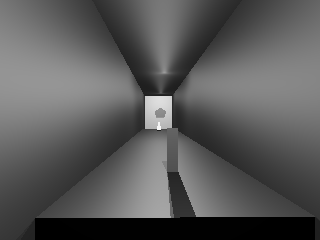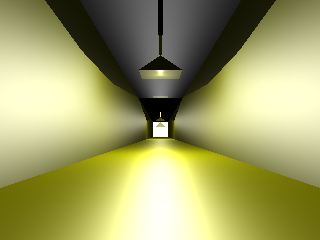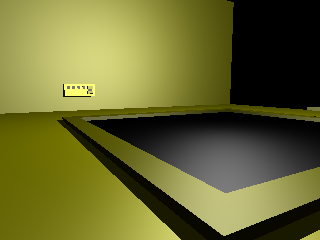Nearly all of Driller is stored in a database that is pretty much machine- independent. On the Spectrum, the database is located at CF3Eh in memory. On the CPC, the database is 79ADh bytes from the beginning of a CPCEMU- format snapshot, which probably makes its address 78ADh. On the PC version, the database is 9B40h bytes from the start of DRILLE.EXE.
A lot of this document will make more sense if you've used the 3D Construction kit or read its manual.
 |
 |
 |
 |
+0 DB room_count +1 DW length_of_database +3 DB start_location_id +4 DB start_entrance ;ID of entrance within room +5 DB +6 DB Initial jet energy +7 DB Initial jet shield +8 DB Initial probe energy +9 DB Initial probe shield +0Ah DS 3Ch ;Shade patterns +46h DW offset ;Offset of table of ??? from database start +48h DW offset ;Offset of table of global bytecode routines ;from database start ... +0B4h DB 'hh:mm:ss' ;Time limit +0BCh DB +0BDh DB +0BEh DB initial extend, 1 based (so 1 is Extend 0) +0BFh DB +0C0h DB +0C1h DB start in probe (0) or jet (nonzero) +0C2h DB initial step index (0-7) +0C3h DB initial angle index (0-5)
At Database + 0C8h is a table of room definitions. Each entry is the offset from the start of the database of a room. The table can have up to 35 entries; spare ones are filled with zeroes.
In the supplied Driller, we have:
Location ID Address Location ID Address ============================================================== Amethyst 1 0xD0B2 Amethyst stores 19 0xE196 Lapis Lazuli 2 0xD3B1 Obsidian stores 20 0xE354 Emerald 3 0xD541 K2 Complex (Topaz) 21 0xE460 Malachite 4 0xE8BC K1 Complex 22 0xE561 Ruby 5 0xE78E K1/K2 Linker 23 0xE658 Aquamarine 6 0xEAA6 K3 Complex (Beryl) 25 0xF8A9 Beryl 7 0xEC63 Hangar 27 0xF68D Topaz 8 0xD747 K4 Complex 28 0xFB92 Niccolite 9 0xEE3F Unknown (Basalt) 31 0xE6D2 Alabaster 10 0xF044 Mitral 32 0xFA20 Opal 11 0xF21A End screen 127 0xFA9E Quartz 12 0xF37E Diamond 13 0xF519 Obsidian 14 0xD995 Basalt 15 0xDBED Ochre 16 0xDD6D Graphite 17 0xDEB7 Trachyte 18 0xE01B ===============================================================Format of a room is:
+0 DB Meaning unknown. +1 DB number of objects in the room +2 DB room ID number +3 DW offset from start of room to room bytecode routines +5 DB scale ;Room scale; 1 is normal for outside areas. ;If you set it to 15 you get a bizarre ;room where gas rigs come up to your waist. ; ; I'm calling the next 4 bytes "Palette 0" to "Palette 3". On the Spectrum ; their meanings are as given below, but on the CPC and PC they are ; selections of which inks to use from the palette. ; +6 DB border ;[palette 0] Normal border colour +7 DB sensbdr ;[palette 1] Border colour when under fire +8 DB paper ;[palette 2] Background colour of room ; (+8 if BRIGHT) +9 DB ink ;[palette 3] Foreground colour of room +10 DB x,z ;Coordinates of the gas pocket +12 DB diameter ;Size of the gas pocket. If this is small, ;you have to put the rig right on the centre. +13 DB room_name ;12 bytes +25 objects General object format is: +0 DB type ;Bits 0-4 = type ;Bit 5 set: Object destroyed ;Bit 6 set: Object invisible ;Bit 7 set: Object is initially invisible +1 DB x,y,z ;X,Y,Z coordinates of bounding cube. +4 DB dx,dy,dz ;Dimensions of bounding cube +7 DB id ;Object ID +8 DB len ;Length of this object record. ... additional data ... ; ; Object types are: ; ; 0. Entrance. No additional data. The "dx,dy,dz" fields are used for ; rotation about the X, Y and Z axes. 1 unit in these fields = 5 degrees. ; ; 1. Cube. The shape is given by the bounding cube. ; Additional data are three bytes of textures - 6 nibbles for the ; 6 surfaces. ; ; 2.Sensor ; The bounding cube size is always 0. ; There are 4 bytes of additional data, presumably recording range and ; firing interval. ; ; 3. Rectangle ; ; There is 1 byte of additional data, containing the textures of the two ; surfaces. ; ; 4. Pyramid, point faces east (+X) ; 5. Pyramid, point faces west (-X) ; 6. Pyramid, point faces up (+Y) ; 7. Pyramid, point faces down (-Y) ; 8. Pyramid, point faces north (+Z) ; 9. Pyramid, point faces south (-Z) ; ; There are 7 bytes of additional data: three texture bytes, and then two ; pairs of slope coordinates (s1,s2) and (s3, s4). These are the two opposite ; corners of the narrow surface of the pyramid, relative to the pyramid origin. ; If they are the same, then the pyramid comes to a point. If they are ; different, the pyramid can have a flat top (cf the shed in Amethyst) or a ; wedge shape (cf the "nose" in Malachite). ; ; 10. Line ; ; There are 7 bytes of additional information: ; One texture byte, and then two sets of (x,y,z) coordinates for the start ; and end of the line. ; ; 11. Triangle. As line, but three sets of coordinates. ; 12. Quadrilateral. As line, but four sets of coordinates. ; 13. Pentagon. As line, but five sets of coordinates. ; 14. Hexagon. As line, but six sets of coordinates. ; ; The objects can be longer than these minimum lengths. If so, the remaining ; bytes form bytecode instructions. The opcodes are: ; ; bit 7 set if opcode is executed when object shot. ; clear if opcode is executed when object touched. ; 1 +SCORE a b c ;Add value to the score 2 +ENERGY n ;Add value to energy 3 TOGVIS obj ;Toggle visibility of object here 4 VIS obj ;Show object here 5 INVIS obj ;Hide object here 6 RTOGVIS room obj ;Toggle visibility of object elsewhere 7 RVIS room obj ;Show object elsewhere 8 RINVIS room obj ;Hide object elsewhere 9 INCR var ;Increment variable 10 DECR var ;Decrement variable 11 IFEQ var value ;Only continue if variable matches value 12 SETBIT bit ;Set a bit flag 13 CLRBIT bit ;Clear a bit flag 14 IFBIT bit value ;Only continue if bit matches value 15 SOUND n ;Play sound 16 DESTROY obj ;Destroy object here 17 RDESTR obj ;Destroy object elsewhere 18 GOTO room entrance 19 +SHIELD n ;Increase/decrease shield 20 SETV var value ;Assign value to variable 21 SWAPJET ;Switch vehicle 22-24 ;Unused? 25 SPFX n ;Used to flash the border or change the ;room colours. SPFX works like this: ; SPFX xyh: Set palette (x) to palette ; (y). For example, ; SPFX 31h sets room ink (palette 3) to ; border-under-fire (palette 1). 26 REDRAW ;Redraw window 27 DELAY n ;Wait n/50 sec. 28 SYNCSND n ;Play synchronised sound 29 TOGBIT n ;Toggle bit flag 30 IFVIS obj ;Only continue if object visible 31 IFINVIS obj ;Only continue if object invisible ; ; The room also has its own bytecode collection, at the offset given ; in offsets 3,4. ; ; Format is: ; DB n_subroutines ; DB bytes_in_subroutine ; for each ; DB bytecode ; subroutine
![]()
John Elliott 13-5-2001